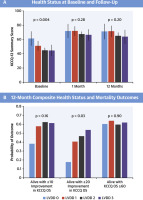当前位置:
X-MOL 学术
›
JACC Cardiovasc. Inte.
›
论文详情
Our official English website, www.x-mol.net, welcomes your
feedback! (Note: you will need to create a separate account there.)
Association Between Diastolic Dysfunction and Health Status Outcomes in Patients Undergoing Transcatheter Aortic Valve Replacement.
JACC: Cardiovascular Interventions ( IF 11.7 ) Pub Date : 2019-11-27 , DOI: 10.1016/j.jcin.2019.08.036 Ali O Malik 1 , Mohamed Omer 1 , Mathew C Pflederer 1 , Ahmed Almomani 1 , Kensey L Gosch 2 , Philip G Jones 2 , Poghni A Peri-Okonny 1 , Firas Al Badarin 1 , Hunter A Brandt 2 , Suzanne V Arnold 1 , Michael L Main 1 , David J Cohen 1 , John A Spertus 1 , Adnan K Chhatriwalla 1
JACC: Cardiovascular Interventions ( IF 11.7 ) Pub Date : 2019-11-27 , DOI: 10.1016/j.jcin.2019.08.036 Ali O Malik 1 , Mohamed Omer 1 , Mathew C Pflederer 1 , Ahmed Almomani 1 , Kensey L Gosch 2 , Philip G Jones 2 , Poghni A Peri-Okonny 1 , Firas Al Badarin 1 , Hunter A Brandt 2 , Suzanne V Arnold 1 , Michael L Main 1 , David J Cohen 1 , John A Spertus 1 , Adnan K Chhatriwalla 1
Affiliation

|
OBJECTIVES
The aim of this study was to assess the association of baseline left ventricular diastolic dysfunction (LVDD) with health status outcomes of patients undergoing transcatheter aortic valve replacement (TAVR).
BACKGROUND
Although LVDD in patients with aortic stenosis is associated with higher mortality after TAVR, it is unknown if it is also associated with health status recovery.
METHODS
In a cohort of 304 patients with interpretable echocardiograms, undergoing TAVR, LVDD was categorized at baseline as absent (grade 0), mild (grade 1), moderate (grade 2), or severe (grade 3). Disease-specific health status was assessed using the 12-item Kansas City Cardiomyopathy Questionnaire overall summary score (KCCQ-OS) at baseline and at 1-month and 12-month follow-up. Association of baseline LVDD with health status at baseline and follow-up after TAVR was assessed using a linear trend test, and association with health status recovery (change in KCCQ-OS) was examined using a linear mixed model adjusting for baseline KCCQ-OS.
RESULTS
Twenty-four (7.9%), 54 (17.8%), 186 (61.2%), and 40 (13.2%) patients had LVDD grades of 0, 1, 2, and 3, respectively. Baseline KCCQ-OS was 61.3 ± 22.7, 51.0 ± 26.1, 44.7 ± 25.7, and 44.4 ± 21.9 (p = 0.004) in patients with LVDD grades of 0, 1,2 and 3. At 1 and 12 months after TAVR, LVDD was not associated with KCCQ-OS. Recovery in KCCQ-OS after TAVR was substantial and similar in patients across all severities of LVDD.
CONCLUSIONS
Although LVDD is associated with health status prior to TAVR, patients across all severities of LVDD have similar recovery in health status after TAVR.
中文翻译:

经导管主动脉瓣置换术患者舒张功能障碍与健康状况结果之间的关联。
目的本研究的目的是评估基线左心室舒张功能障碍(LVDD)与接受经导管主动脉瓣膜置换术(TAVR)的患者的健康状况结局之间的关系。背景技术尽管主动脉瓣狭窄患者的LVDD与TAVR后的较高死亡率相关,但尚不清楚其是否也与健康状况恢复相关。方法在304例行TAVR的可解释超声心动图患者中,LVDD在基线时分类为不存在(0级),轻度(1级),中度(2级)或重度(3级)。在基线时以及在1个月和12个月的随访中,使用12项堪萨斯城心肌病问卷总体总评分(KCCQ-OS)评估疾病特定的健康状况。使用线性趋势测试评估基线LVDD与TAVR基线和随访后健康状况的关联,并使用调整基线KCCQ-OS的线性混合模型研究与健康状况恢复(KCCQ-OS的变化)的关联。结果24例(7.9%),54例(17.8%),186例(61.2%)和40例(13.2%)的LVDD等级分别为0、1、2和3。LVDD等级分别为0、1、2和3的患者,基线KCCQ-OS为61.3±22.7、51.0±26.1、44.7±25.7和44.4±21.9(p = 0.004)。与KCCQ-OS无关。在所有严重度LVDD的患者中,TAVR后KCCQ-OS的恢复相当可观。结论尽管LVDD与TAVR之前的健康状况有关,但是所有严重程度LVDD的患者在TAVR后的健康状况都有相似的恢复。
更新日期:2019-11-27
中文翻译:

经导管主动脉瓣置换术患者舒张功能障碍与健康状况结果之间的关联。
目的本研究的目的是评估基线左心室舒张功能障碍(LVDD)与接受经导管主动脉瓣膜置换术(TAVR)的患者的健康状况结局之间的关系。背景技术尽管主动脉瓣狭窄患者的LVDD与TAVR后的较高死亡率相关,但尚不清楚其是否也与健康状况恢复相关。方法在304例行TAVR的可解释超声心动图患者中,LVDD在基线时分类为不存在(0级),轻度(1级),中度(2级)或重度(3级)。在基线时以及在1个月和12个月的随访中,使用12项堪萨斯城心肌病问卷总体总评分(KCCQ-OS)评估疾病特定的健康状况。使用线性趋势测试评估基线LVDD与TAVR基线和随访后健康状况的关联,并使用调整基线KCCQ-OS的线性混合模型研究与健康状况恢复(KCCQ-OS的变化)的关联。结果24例(7.9%),54例(17.8%),186例(61.2%)和40例(13.2%)的LVDD等级分别为0、1、2和3。LVDD等级分别为0、1、2和3的患者,基线KCCQ-OS为61.3±22.7、51.0±26.1、44.7±25.7和44.4±21.9(p = 0.004)。与KCCQ-OS无关。在所有严重度LVDD的患者中,TAVR后KCCQ-OS的恢复相当可观。结论尽管LVDD与TAVR之前的健康状况有关,但是所有严重程度LVDD的患者在TAVR后的健康状况都有相似的恢复。











































 京公网安备 11010802027423号
京公网安备 11010802027423号